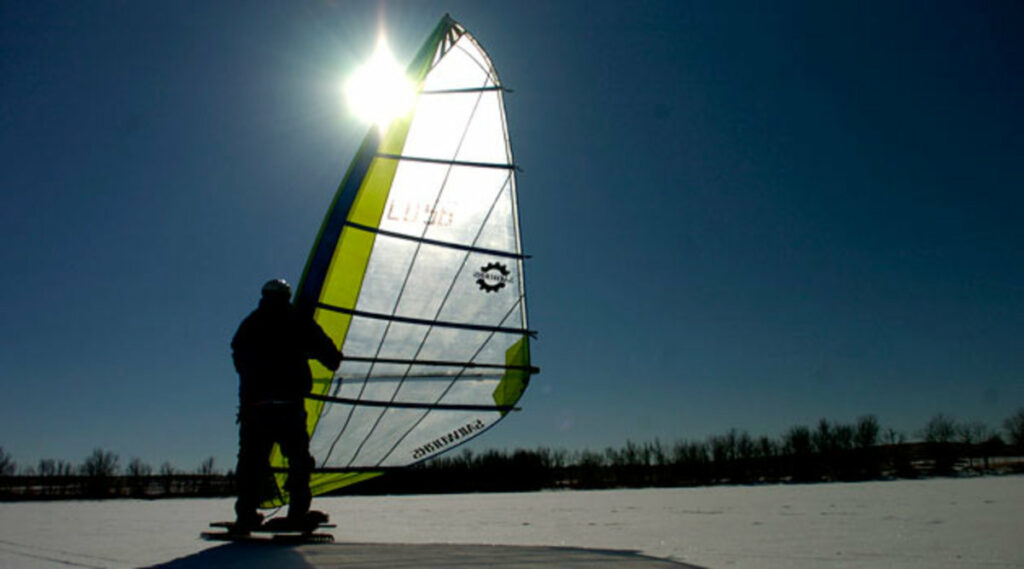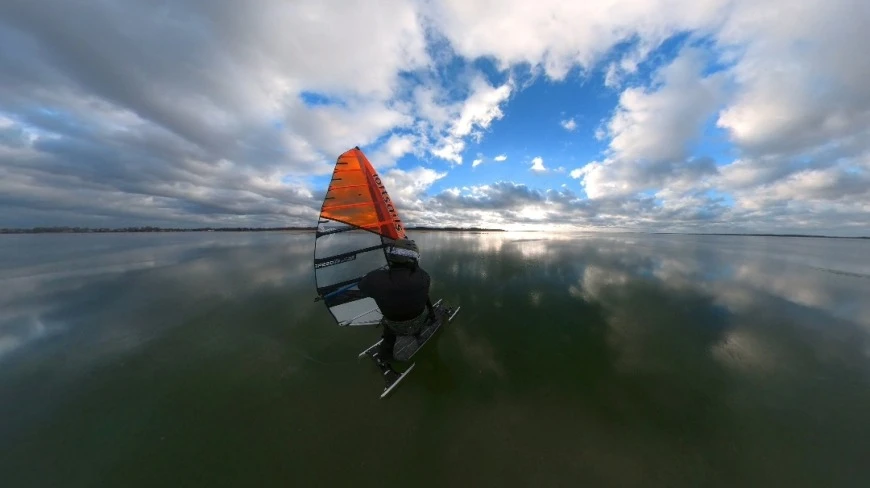Icesurfing is an emerging winter sport that combines the excitement of surfing with the unique challenges of icy terrain. This article provides essential information for those interested in getting started with icesurfing, including foundational knowledge about the sport, necessary gear, safety tips, and insights into the growing community surrounding this thrilling activity. Whether you’re a seasoned adventurer or a beginner looking to try something new, this guide will help you navigate your journey into the world of icesurfing safely and effectively.
In this article you will find:
What is Icesurfing and How to Get Started
Icesurfing is an exhilarating winter sport that combines elements of surfing, windsurfing, and ice skating. Picture gliding across frozen lakes or snow-covered fields on a specially designed board, propelled by the wind in a way that feels both liberating and electrifying. This unique sport is rapidly gaining popularity among adventure seekers, offering a thrilling way to enjoy the winter landscape while experiencing the rush of speed and agility.
The Basics of Icesurfing
At its core, icesurfing involves riding a board on ice or snow while harnessing the power of the wind. Participants use a sail attached to the board to catch the wind, allowing them to maneuver across the icy surface. The sport is accessible to those who have experience with windsurfing or snowboarding, but it can also be enjoyed by beginners with the right guidance and equipment.
Getting Started with Icesurfing
If you’re eager to dive into the world of icesurfing, here are some essential steps to help you get started:
- Research and Learn: Before hitting the ice, take the time to research the sport. Watch videos, read articles, and follow experienced icesurfers on social media to understand the techniques and skills involved.
- Find a Local Icesurfing Community: Joining a community can enhance your learning experience. Look for local clubs or groups that offer lessons and organize events. Websites like icesurfing.com can provide valuable resources and connections.
- Take a Lesson: Consider enrolling in a lesson with a qualified instructor. They can teach you the fundamentals, including safety protocols, proper techniques, and equipment handling.
- Invest in Quality Gear: Having the right equipment is crucial. Look for specialized icesurfing boards and sails that suit your skill level. Safety gear, including helmets and pads, is also important to protect yourself from falls.
- Practice in Safe Conditions: Start in calm, open areas where you can practice without obstacles. Pay attention to weather conditions and ice thickness to ensure your safety.
Embracing the Thrill
Once you’ve mastered the basics, you can begin to explore different styles and techniques in icesurfing. As you gain confidence, you might want to participate in local competitions or events that celebrate this exciting sport. Embrace the thrill of the wind in your hair and the freedom of gliding over the ice, and you’ll find yourself captivated by the magic of winter.
As you embark on your icesurfing journey, remember to stay informed about safety practices and equipment maintenance to ensure a rewarding experience. The world of icesurfing awaits, offering endless opportunities for adventure and fun!
 Essential Gear for Icesurfing Adventures
Essential Gear for Icesurfing Adventures
As you prepare to embark on your icesurfing journey, having the right gear is crucial for both performance and safety. The unique demands of this winter sport require specialized equipment designed to withstand cold conditions while enhancing your experience on the ice. Below, we outline the essential gear you’ll need to get started and make the most of your icesurfing adventures.
1. Icesurfing Board
The foundation of your icesurfing experience lies in the icesurfing board. These boards are specifically designed to glide smoothly over ice and snow, often featuring a lightweight construction for easy maneuverability. When selecting a board, consider the following:
- Size: Choose a board that matches your height and weight for optimal performance.
- Material: Look for boards made from durable materials like fiberglass or carbon fiber, which provide both strength and flexibility.
- Design: Consider the board’s shape, as different designs cater to various styles of riding, from cruising to racing.
2. Sail and Rigging
The sail is another critical component of your icesurfing setup. It captures the wind to propel you across the ice. Here’s what to keep in mind:
- Size: The size of the sail should correspond to your skill level and the wind conditions. Beginners might benefit from smaller sails that are easier to handle.
- Material: Look for sails made from lightweight, durable fabrics that can withstand cold temperatures and strong winds.
- Rigging: Ensure you have a quality rigging system that allows for easy setup and adjustment of the sail during your session.
3. Safety Gear
Safety should always be a top priority when engaging in any sport. For icesurfing, the following safety gear is essential:
- Helmet: A properly fitting helmet can protect your head in case of falls or collisions.
- Wrist Guards: Protect your wrists from injury during falls, which are common as you learn to balance on the board.
- Knee and Elbow Pads: These pads provide additional protection for your joints, helping to prevent bruises and scrapes.
- Cold Weather Clothing: Dress in layers using moisture-wicking fabrics, insulated jackets, and waterproof pants to stay warm and dry.
4. Footwear
Your choice of footwear can significantly impact your comfort and performance on the ice. Look for:
- Insulated Boots: Select boots that are warm, waterproof, and provide good ankle support.
- Non-Slip Soles: Ensure your boots have a non-slip sole for better traction on icy surfaces.
5. Accessories
Lastly, consider some additional accessories that can enhance your icesurfing experience:
- Gloves: Insulated gloves will keep your hands warm while allowing for dexterity to control the sail.
- Safety Whistle: A whistle can be a vital tool for signaling for help if needed.
- Backpack: A waterproof backpack is useful for carrying your gear and personal items to and from the ice.
By investing in the right icesurfing gear, you’ll be well-prepared to embrace the thrills of this exciting winter sport. For further information on quality equipment, check out icesurfing.com for trusted recommendations and reviews.
Safety Tips for Enjoying Icesurfing This Winter
As with any thrilling outdoor sport, icesurfing comes with its own set of risks. Ensuring your safety while enjoying this exciting winter activity is paramount. Below, we outline essential safety tips that will help you navigate the icy terrain and make the most of your icesurfing experience.
1. Assess Ice Conditions
Before heading out, it’s crucial to evaluate the ice conditions. Not all ice is safe for icesurfing, and understanding how to assess it can prevent accidents:
- Thickness: Ensure the ice is at least 4 inches thick for safe recreational activities. Ice thickness can vary, so always check multiple areas.
- Color: Clear blue or black ice is generally stronger than white or cloudy ice, which can indicate air pockets or weak spots.
- Weather Conditions: Be aware of recent weather changes that could affect ice stability, such as warming temperatures or heavy snowfall.
2. Wear Proper Safety Gear
Investing in and wearing the right safety gear is essential for minimizing injuries:
- Helmet: Always wear a helmet to protect your head from falls and collisions.
- Protective Pads: Wrist guards, knee pads, and elbow pads can help prevent injuries during falls.
- Cold Weather Clothing: Dress in layers with moisture-wicking materials, insulated jackets, and waterproof pants to stay warm and dry.
3. Buddy System
Never go icesurfing alone. Having a partner or a group not only enhances the fun but also increases safety:
- Communication: Establish a plan for checking in with each other during your session.
- Emergency Preparedness: Carry a first aid kit and know how to use it. Make sure at least one person in your group knows basic first aid.
4. Know Your Limits
Understanding your skill level is key to staying safe on the ice:
- Practice: Start in calm conditions and practice basic techniques before attempting more advanced maneuvers.
- Avoid Overexertion: Take breaks to avoid fatigue, which can lead to accidents. Listen to your body and know when to stop.
5. Stay Aware of Your Surroundings
Awareness is crucial for safety in any sport, especially in icesurfing:
- Watch for Hazards: Be mindful of obstacles such as cracks, open water, or other people on the ice.
- Wind Conditions: Keep an eye on changing wind patterns that could affect your ability to control the sail.
6. Use a Safety Whistle
A safety whistle can be a lifesaver in emergencies:
- Visibility: A whistle can alert your partner or nearby individuals if you need assistance.
- Compact and Convenient: Keep a whistle attached to your gear for easy access.
By following these safety tips, you can enjoy the thrill of icesurfing while minimizing risks. For more detailed information on safety practices and equipment, consider visiting safetyfirst.com for comprehensive guides and resources. Remember, a safe adventure is a fun adventure!
 The Growing Community and Events in Icesurfing
The Growing Community and Events in Icesurfing
The world of icesurfing is not just about the adrenaline rush of gliding across frozen lakes; it’s also about community and connection. As this winter sport gains popularity, a vibrant community is emerging, bringing together enthusiasts from all walks of life. This section explores the growth of the icesurfing community, key events, and how you can get involved.
The Rise of the Icesurfing Community
As more people discover the thrill of icesurfing, local clubs and online communities are flourishing. These groups provide a platform for sharing experiences, tips, and resources. Here are some notable aspects of the growing community:
- Social Media Groups: Platforms like Facebook and Instagram have become hotspots for icesurfing enthusiasts to share videos, photos, and advice. Joining these groups can help you connect with fellow surfers and stay updated on trends.
- Local Clubs: Many regions now have local icesurfing clubs that organize meetups, training sessions, and social events. These clubs foster camaraderie and provide a supportive environment for both beginners and experienced surfers.
- Online Forums: Websites and forums dedicated to winter sports often feature sections on icesurfing, allowing for deeper discussions about techniques, gear, and safety.
Key Events in Icesurfing
Events are vital for building community and promoting the sport. They offer opportunities for participants to showcase their skills, learn from others, and compete in a friendly atmosphere. Some notable events include:
- Icesurfing Competitions: Local and national competitions are springing up, allowing surfers to compete for titles and recognition. These events often feature various categories, from speed races to freestyle displays.
- Winter Festivals: Many winter sports festivals now include icesurfing demonstrations and competitions as part of their lineup. These festivals celebrate winter sports and provide a platform for showcasing the excitement of icesurfing.
- Workshops and Clinics: Look for workshops hosted by experienced icesurfers or professionals. These events focus on skill development, safety practices, and gear maintenance, making them perfect for beginners and seasoned surfers alike.
Getting Involved
If you’re interested in becoming part of the growing icesurfing community, here are some steps to get involved:
- Join Local Clubs: Search for local icesurfing clubs in your area and attend their meetings or events. This is a great way to meet like-minded individuals and learn more about the sport.
- Participate in Events: Sign up for competitions or festivals, even if you’re a beginner. These events are often welcoming and provide a great atmosphere for learning and fun.
- Engage Online: Follow icesurfing pages on social media and participate in discussions. Sharing your experiences and asking questions can enhance your learning and connection with others.
Future of Icesurfing
The future of icesurfing looks bright, with an increasing number of enthusiasts and events. As the community continues to grow, so will the opportunities for collaboration, innovation, and fun. With the rise of social media and online platforms, staying connected with fellow surfers has never been easier. Embrace the thrill of icesurfing, and you may find yourself part of an exciting and supportive community.
For more information on upcoming events and community resources, check out icesurfingevents.com for the latest updates and opportunities to connect with fellow enthusiasts. Icesurfing is an exciting winter sport that combines elements of surfing, windsurfing, and ice skating, allowing participants to glide across frozen surfaces propelled by the wind. To get started, it’s essential to research the sport, join local communities, take lessons, invest in quality gear, and practice in safe conditions. Key equipment includes a specialized board, sail, safety gear, and appropriate footwear.
Safety is paramount in icesurfing; always assess ice conditions, wear protective gear, and never surf alone. Engaging with the growing icesurfing community through local clubs and events can enhance your experience, providing opportunities for skill development and camaraderie. For more information on events and resources, visit platforms like icesurfingevents.com to stay connected with fellow enthusiasts.


 Essential Gear for Icesurfing Adventures
Essential Gear for Icesurfing Adventures The Growing Community and Events in Icesurfing
The Growing Community and Events in Icesurfing

